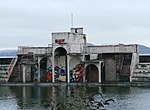Kents Bank
EngvarB from June 2016Grange-over-SandsMorecambe BayVillages in Cumbria

Kents Bank is a small village in Cumbria, England, so named for its proximity to the River Kent estuary. Part of the historic County Palatine of Lancashire, it is located 2 miles (3.2 km) south-west of Grange-over-Sands.
Excerpt from the Wikipedia article Kents Bank (License: CC BY-SA 3.0, Authors, Images).Kents Bank
Embankment Path,
Geographical coordinates (GPS) Address Nearby Places Show on map
Geographical coordinates (GPS)
| Latitude | Longitude |
|---|---|
| N 54.17282 ° | E -2.92525 ° |
Address
Kent Banks
Embankment Path
LA11 7BG
England, United Kingdom
Open on Google Maps









